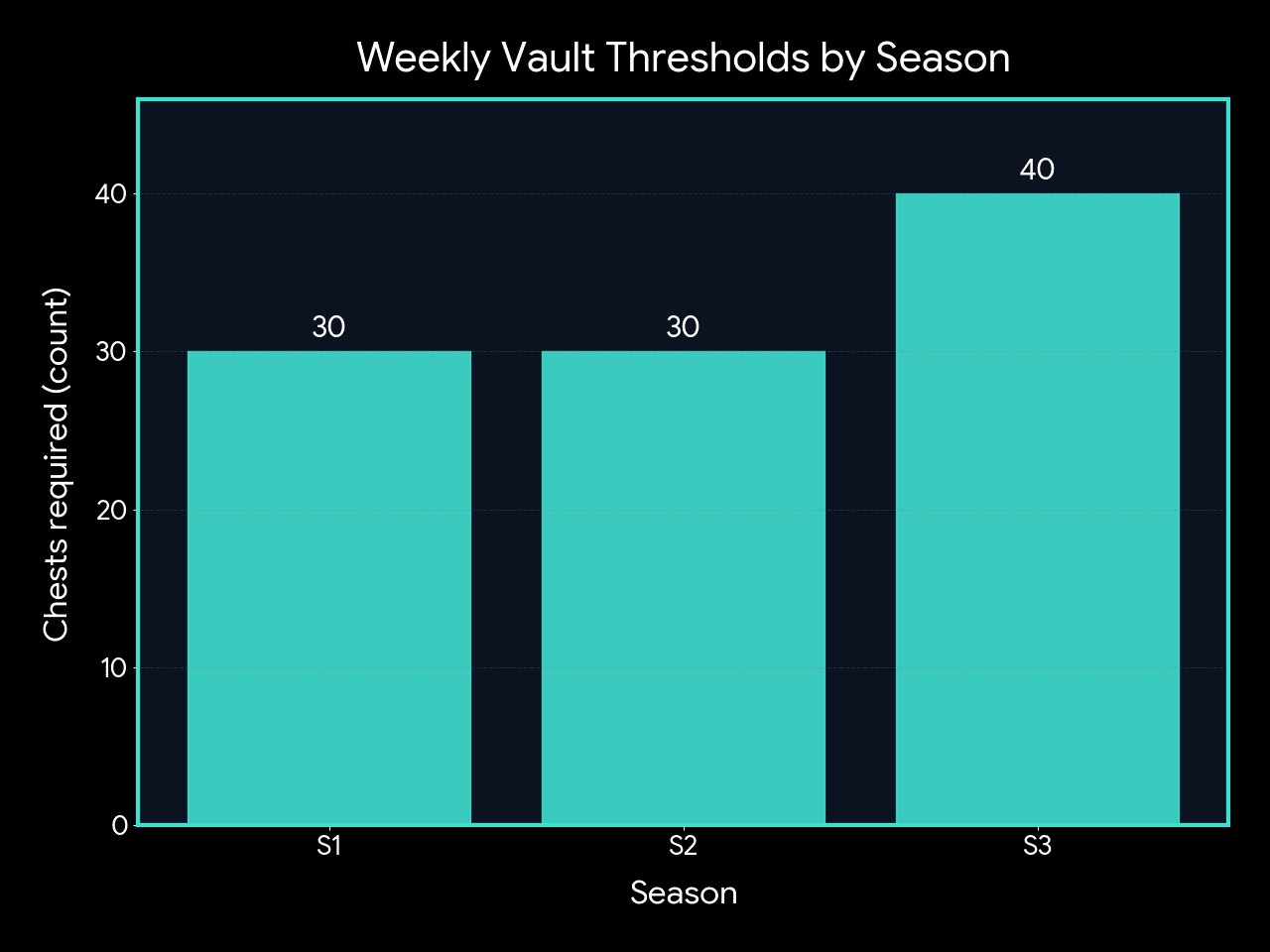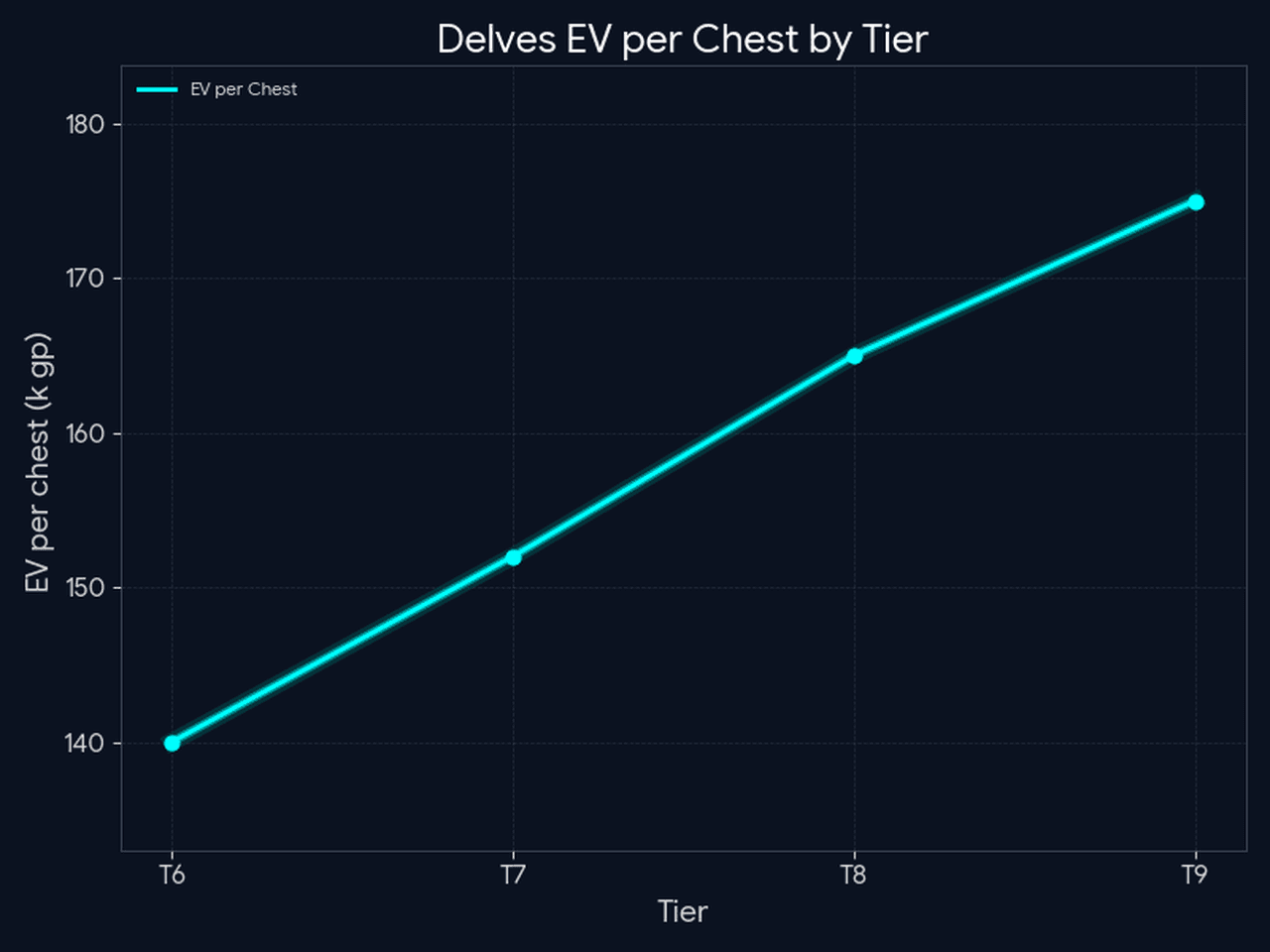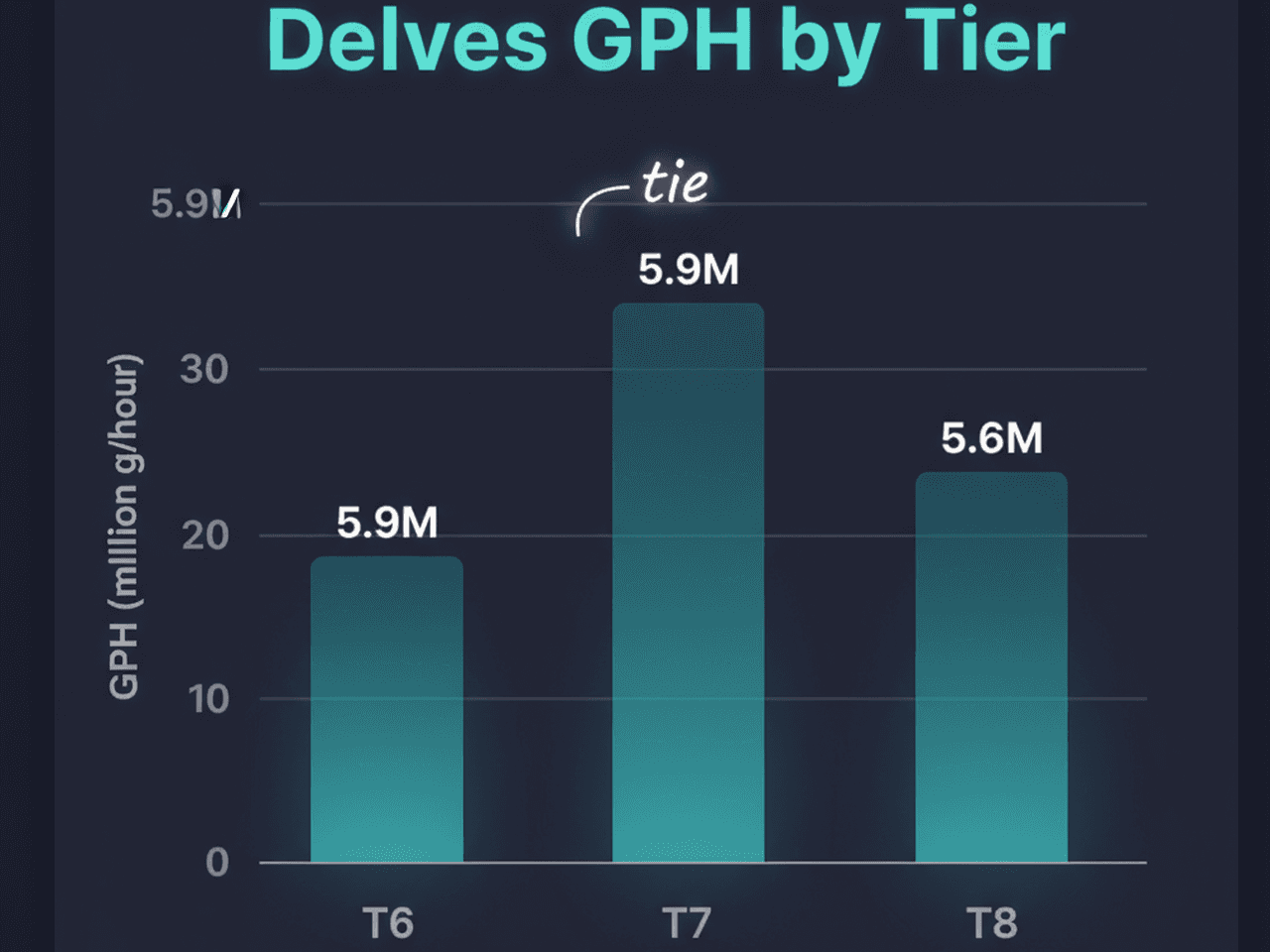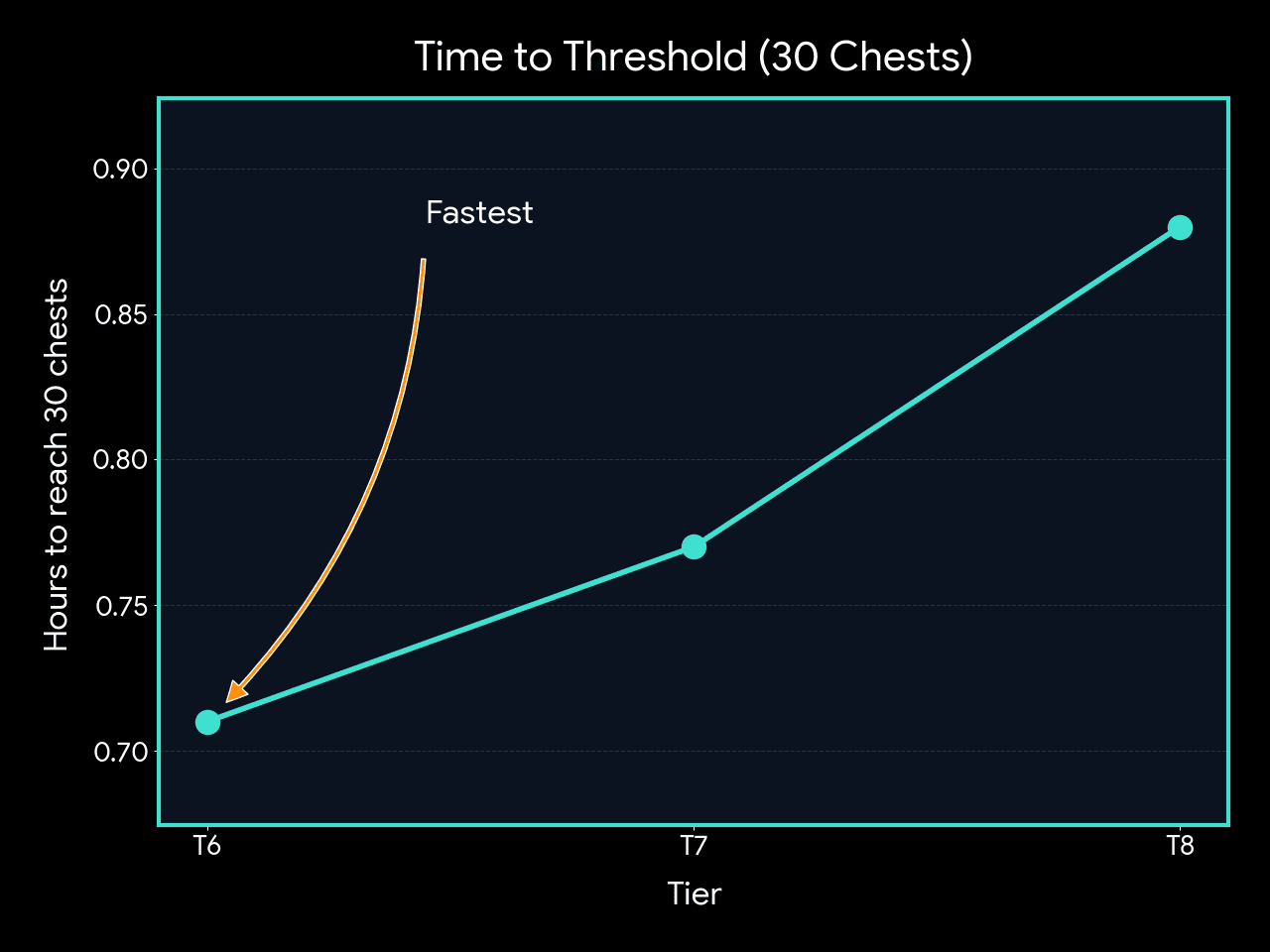WoW Delves Tiers, Vault Thresholds & GPH (2025 Guide)
Delves look simple—pick a tier, open chests, get the Weekly Vault—yet efficiency hinges on two numbers: EV per chest and GPH. This guide shows how to choose tiers, hit Vault thresholds at the least time cost, and turn your runs into repeatable, shareable setups. When you're ready to plug in your own values, use the interactive Delves Calculator. Definitions for EV and GPH live in Glossary: Expected Value and Glossary: Gold per Hour; roll behavior is covered under Independent trials.

Seasons & Weekly Vault Thresholds
Delves tiers change how hard enemies hit and how much the per-chest EV scales, and each season comes with a Vault threshold—a simple target: open at least N chests in a week to secure a Vault slot. Picking a tier is not just about raw EV; it's the time needed to reach the threshold and how that time compares across tiers.
→ Delves tiers & what they really change
- Enemy scaling: higher tiers increase time per pull, elite HP, and death risk.
- EV scaling: per-chest rewards typically climb with tier, but not always linearly.
- Route variance: higher tiers magnify route mistakes—long wipes erase EV gains.
→ Weekly Vault threshold basics
- Each season specifies a chests-opened threshold (e.g., 20, 30, 40+).
- Your aim is to hit the smallest time cost that crosses the threshold.

Formula: effective weekly time
Weekly time ≈ Vault threshold ÷ Chests/hour at chosen tierAssumption: stable routing
This formula assumes no wipes and average map density. Real runs vary—track your actual chests/hour over multiple sessions.
Tip: adjust if you frequently stop short of thresholds
If you frequently stop short (e.g., 27/30), adjust routes or drop a tier to improve consistency and reduce frustration.
→ When to climb, when to hold
- Climb a tier if the EV/hour increase exceeds the extra time per run.
- Hold if a tier up forces longer routes with little EV gain or destabilizes clears.
- Test each tier for 3-5 runs before committing to avoid false impressions from lucky or unlucky first attempts.
Two Core Metrics: EV per Chest & GPH
You'll see both on the calculator. They answer different questions and must work together to optimize your farming efficiency.

→ EV per chest (Expected Value)
- What it is: your average loot value per chest after many runs.
- Why it matters: isolates loot quality independent of route time.
- See Glossary: Expected Value for the math.
Display vs. reality
EV is an average, not a guarantee. High-variance loot can hide long dry streaks, so plan with confidence intervals when your sample size is small. The calculator helps you understand this variance.
Caveat: route efficiency matters
Route changes that reduce chests/hour don't change EV/chest but will lower GPH. Always optimize your path for maximum chests opened per hour.
→ GPH (Gold per Hour)
- What it is: time-normalized efficiency; the loot you actually earn per hour.
- Why it matters: it's the metric that pays for your consumables and upgrades.
- See Glossary: Gold per Hour for definition details.
Connection between EV and GPH
GPH = EV/chest × Chests/hourExample calculation
If EV/chest = 140,000 and you open 40 chests/hour:
GPH ≈ 140,000 × 40 = 5.6M gold/hour
Independent rolls & threshold thinking
Delves chest outcomes are effectively independent rolls. Target-farming specific tables? Use Independent trials to estimate "at least once" odds over many chests.
Note on vault threshold vs optimization
Vault thresholds care about count, not specific drops. EV/GPH optimization and threshold planning are related but not identical tasks—optimize for both separately.
Practical Workflow: Pick a Tier, Route & Pace
This is the step-by-step the calculator is designed for. Open Delves Calculator in another tab and follow along.
→ Step 1: Start from the Vault threshold
- Read the current season's threshold (e.g., 30 chests).
- Decide whether you want only the Vault or Vault plus farm income.
Rule of thumb for limited playtime
If your playtime is limited, optimize for time-to-threshold first, then push GPH with any remaining hours. This ensures you never miss weekly rewards.
→ Step 2: Pick 2-3 candidate tiers
- Choose neighboring tiers (e.g., T6/T7/T8) to A/B test.
- Record time per run, wipes, and average chests per run over 2-3 samples each.
Tip: avoid single-run judgments
Don't judge on one run; Delves have route RNG. Three runs minimum per tier gives you a realistic baseline for comparison.
→ Step 3: Measure EV/chest and route time
For each tier:
- Compute EV/chest (use the calculator's placeholder table, then override when you have real data).
- Measure travel time and chests/hour with your current route.
Example numbers (tier comparison)
| Tier | EV/chest | Chests/hour | GPH |
|---|---|---|---|
| T7 | 150k | 38 | ≈ 5.7M |
| T8 | 165k | 34 | ≈ 5.6M |
Interpretation: higher tier paradox
Higher tier raised EV/chest but lowered GPH due to time. This is common—always measure both metrics before choosing your farming tier.
→ Step 4: Compute time-to-threshold
Use the formula: weekly time ≈ Vault threshold ÷ chests/hour.
Worked example (30 chest threshold)
- T7:
30 ÷ 38 ≈ 0.79h - T8:
30 ÷ 34 ≈ 0.88h
Decision logic
If you only care about the Vault, T7 is strictly better here. Save 0.09 hours per week and maintain similar GPH for additional farming.
→ Step 5: Lock a route & export a shareable setup
- When a tier wins both time-to-threshold and GPH (or satisfactorily trades one for the other), lock it in.
- Save your share link in the calculator for future reference and to share with guildmates.
Maintenance: re-check weekly
Patch notes and hotfixes can move prices and EV tables. Re-validate your chosen tier after major updates to ensure continued efficiency.
Costs, Time Sinks & False Gains
Efficiency isn't just the EV number—you need to subtract costs and avoid illusions that look like gains but aren't.
→ Consumables & repair costs
Track flasks, food, stones, scrolls, repairs, and extra travel costs.
Net GPH formula
Net GPH = GPH(gross) − Costs/hourTip: factor in wipe costs
High-tier wipe risk can balloon repairs; a "slower" tier may net more after accounting for death penalties and repair bills.
→ Time padding & fake progress
- Queue/AFK/auction spikes don't advance your threshold but consume session time.
- Use a stopwatch to time only active Delves; pause during city breaks and vendor runs.
- Route discipline: cut scenic detours; prioritize consistent chest loops over exploration.
The EV mirage
Higher EV/chest is meaningless if chests/hour tanks. Always validate your optimization claims with timed sessions.
Reality check method
Run both tiers for 30 minutes each and compare net gold earned. This eliminates theoretical bias and reveals true efficiency.
Case Study Workflow (Reproducible Example)
Let's put the workflow into a reproducible script you can copy every week and adapt to your own playtime constraints.
→ Profile & goals
- Playtime: 4 hours/week
- Goal: Hit Vault and then farm for 2 hours with best net GPH
- Season threshold: 30 chests
→ Candidate tiers & samples (3 runs each)
| Tier | EV/chest | Chests/hour | GPH | Time to 30 |
|---|---|---|---|---|
| T6 | 140k | 42 | ≈ 5.9M | 0.71h ⭐ |
| T7 | 152k | 39 | ≈ 5.9M | 0.77h |
| T8 | 165k | 34 | ≈ 5.6M | 0.88h |
Decision logic breakdown
- If you only want the Vault → T6 wins on time (0.71h vs 0.77h vs 0.88h).
- If you also farm → T6 and T7 tie on GPH; pick the more stable route.
Final pick recommendation
T6 for thresholding; T7 as an optional "farm" variant if it feels smoother and cost-stable. Test both for your gear level and route familiarity.
→ Time-to-threshold comparison
Understanding how long it takes to reach the Vault threshold at different tiers is crucial for planning your weekly farming schedule. Lower tiers reach thresholds faster but may offer lower EV per chest.

Frequently Asked Questions
Q: Is a higher Delves tier always better for profit?
No. If EV/chest rises but chests/hour falls more, GPH drops. Test adjacent tiers with your real route and measure actual gold earned per hour session.
Q: What if I can't hit the Vault threshold every week?
Lower the tier or streamline your route. Your first priority is time-to-threshold, then push GPH on remaining playtime. A Vault reward secured is worth more than theoretical GPH you never achieve.
Q: Should I stack group buffs to push tiers?
Group buffs help consistency, but if they slow starts/queues, you may lose net GPH. Measure active Delves time only—exclude waiting periods from your calculations.
Q: Can I model "at least one target drop" in Delves?
Use independent rolls math and run counts. See Independent trials. For EV/GPH planning, keep target-drop variance separate from threshold math.
Q: How often should I re-check my tier choice?
Revisit after balance notes or significant price swings. At minimum, validate once per season start. Use the calculator's shareable URL to track your historical setups.
Methodology & Sources
How to reproduce these calculations and validate your own tier choices.
- EV/chest is computed from chest loot tables and market prices where applicable, then averaged; see Glossary: Expected Value.
- GPH multiplies EV/chest by observed chests/hour from your route.
- Chests/hour is measured with a stopwatch on active instances only.
- Sample values above are placeholders—override them with your own data in the Delves Calculator.
- Known variances: density RNG, death/wipe outliers, travel time drift, patch-day price shifts.
Replication steps
- Time three runs per tier; discard the worst outlier if a wipe occurred.
- Record EV/chest and chests/hour; compute GPH & time-to-threshold.
- Pick the tier with minimal weekly time; tie-break on net GPH (after costs).
Update cadence
Revisit after balance notes or price swings. Weekly validation recommended during season start.
Shareable setups
Use the calculator's copy-URL to preserve your inputs and share optimized routes with guildmates.